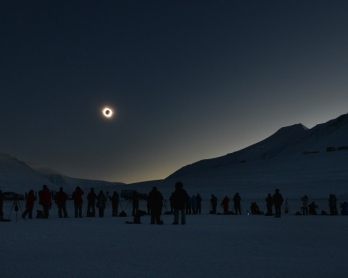Full moon risin'
Paris - You don’t want to miss a supermoon rising when you’re a photographer, especially when it’s the closest a full moon has been to the Earth in 68 years and with 18 years to wait until it gets as near.
So AFP shooters all over the world got ready for the occasion, thinking up of the best spots and angles, doing practice runs, talking it over with colleagues and praying for clear skies on D Night.
In the end, some trudged through hills parched with thirst to get their shot; others waited patiently, be it for the clouds to lift for just a few minutes, or for various elements in the frame to come together, or simply for the moon to make its way above their city. And some didn’t plan at all, but just happened to have noticed a great shot on the way home from an assignment.
Herewith a collection of some of our favorite pictures of the phenomenon. Enjoy and see you again in November, 2034.
Myanmar
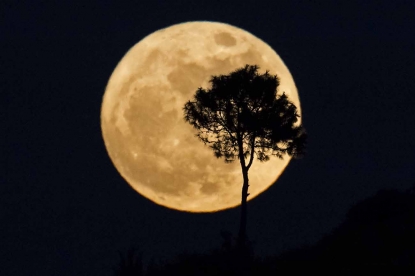 The 'supermoon' over Heho, in Myanmar's Shan state.
(AFP / Ye Aung Thu)
The 'supermoon' over Heho, in Myanmar's Shan state.
(AFP / Ye Aung Thu)By Ye Aung Thu
I calculated with a mobile app the time that the moon would come out -- 5:00 pm. I knew a hillside area that I thought would make for a nice place to shoot, a three-hour drive away, so I left my house at noon to get there in time to scout the place and set up my equipment.
There are no roads in those hills, so I drove in muddy farm fields and on the hills themselves, looking for a nice foreground subject to photograph against the moon. Once I found one -- a tree -- I calculated how far away I should be to get a nice shot. The optimal distance was on top of a nearby hill, so I began to hike. I had forgotten my water bottle in the car, and climbing hills dragging a 600 mm lens, a 70-200 mm lens and 2 Nikon bodies was not something I would like to do again. Once in my prime position, I waited for about an hour. Once the moon rose, I clicked away.
London
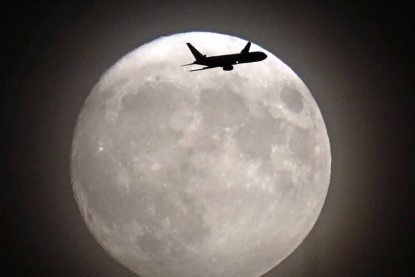 The 'supermoon' in west London.
(AFP / Adrian Dennis)
The 'supermoon' in west London.
(AFP / Adrian Dennis)By Adrian Dennis
I had been watching the weather forecast closely ahead of the “supermoon.” The day before it was to appear, I drove close to Heathrow airport to investigate a couple of locations and to see if the airplanes were approaching from east, where it would rise. I was in luck, I found a spot where the incoming aircraft were coming straight toward me and I used the compass on my phone to try to align them at approximately 75 degrees to where I was standing -- this was roughly where the moon would appear over the horizon.
On the actual night, when the moon appeared, it was further out of my frame than I had expected. As it was too late at this point to move, I waited for the moon to rise in the sky before a couple of planes passed directly in front within five minutes. Unfortunately there was rain and heavy clouds in south of England that night, so I didn’t see the moon at its closest.
Marseille, France
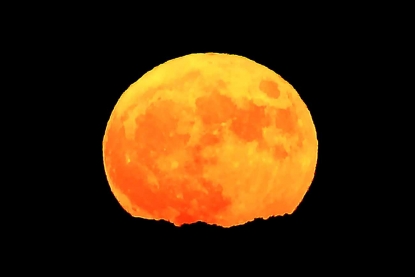 The 'supermoon' over Marseille.
(AFP / Boris Horvat)
The 'supermoon' over Marseille.
(AFP / Boris Horvat)By Boris Horvat
I knew the moon would come up in the east and the place in Marseille where you can see the entire city while facing east is the top of the Notre Dame de la Garde hill. It’s also a nice location because you can move around freely. So I set up there and waited. Once it came up, it was red for only the few minutes in the beginning
Baikonur, Kazakhstan
 The 'supermoon' behind the Soyuz spacecraft on the launch pad in Baikonur in Kazakhstan.
(AFP / Kirill Kudryavtsev)
The 'supermoon' behind the Soyuz spacecraft on the launch pad in Baikonur in Kazakhstan.
(AFP / Kirill Kudryavtsev)By Kirill Kudryavtsev
Knowing that we would be at Baikonur when the “supermoon” came out, my colleagues from the other news agencies and I had been discussing for two weeks the best points to shoot it. We’ve all been to Baikonur before, covering the launches, so we knew the cosmodrome complex pretty well.
We decided to set up about 1.6 kilometers away from the rocket. Unfortunately, that evening it was cloudy in the Kazakh steppe, so for the first hour and a half after it rose, we didn’t see it at all. We were all standing there, with our cameras set up, changing the settings every time we thought that it might come out.
Then we saw a red line close to the rocket. I changed my aperture and shutter speed for the fifth time, because the moon was very bright and the launching pad was in the shadows. We got lucky as well, because the rocket service towers were raised as part of the preparations for the launch while the moon was coming out.
Seville, Spain
 The 'supermoon' over Seville.
(AFP / Cristina Quicler)
The 'supermoon' over Seville.
(AFP / Cristina Quicler)By Cristina Quicler
I shot the moon from Tomares, a town next to Seville. There is an outlook there from where you can see the entire city of Seville on a clear day. I chose the spot because it gave me a nice, clean shot of the city and didn’t have any foreground elements. Plus I could move around.
Ahmedabad, India
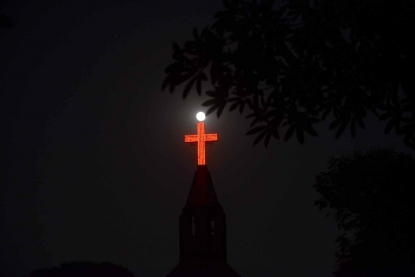 The 'supermoon' rises above the Holy Cross of CNI Christ Church, Mirzapur in Ahmedabad in India.
(AFP / Sam Panthaky)
The 'supermoon' rises above the Holy Cross of CNI Christ Church, Mirzapur in Ahmedabad in India.
(AFP / Sam Panthaky)By Sam Panthaky
I didn’t plan for this shot at all. I was coming home after a shoot, when I noticed the “supermoon” over a church in Mirzapur. I drove up and asked the security guard at the entrance of the church to let me in to take some pictures. He obliged and I clicked away. Sometimes you just get lucky. Being observant pays.
Yangon, Myanmar
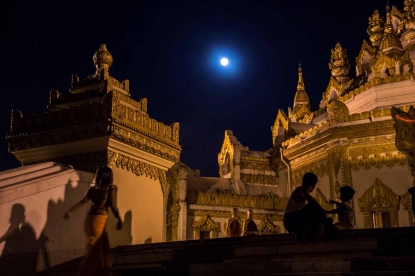 The Buddhist faithful at the Swe Taw Myat Pagoda in Yangon under a rising 'supermoon.'
(AFP / Romeo Gacad)
The Buddhist faithful at the Swe Taw Myat Pagoda in Yangon under a rising 'supermoon.'
(AFP / Romeo Gacad)By Romeo Gacad
Ahead of the “supermoon,” I thought a lot about which pagoda in Yangon might make the best element in the picture. Once I found the right one, I practiced for two nights, to find the perfect angle and to practice time lapses. In Myanmar, the Buddhist majority celebrates religious festivals based on full moons. That’s what they have done since ancient times. So for me the challenge was to combine the feeling of solemn religious celebration with the image of the “supermoon.”
On the night the moon appeared, I went to the Swe Taw Myat Pagoda with 2 Nikon D4s camera, one set on a tripod with a wide angle lens for the three-hour time lapse and the other with a 28-300 mm zoom to frame the worshippers, the supermoon and the intricate architectural beauty of the pagoda itself.
It took a lot of patience to get the right moment, like waiting for a perfect planetary alignment.
Corinth, Greece
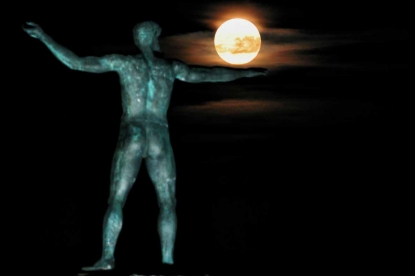 The 'supermoon' on Poseidon's arm.
(AFP / Valerie Gache)
The 'supermoon' on Poseidon's arm.
(AFP / Valerie Gache)By Valerie Gache
I thought it would be interesting to give the “supermoon” some mythical importance. In Corinth, there is a statue of Poseidon, the god of the sea in Greek myths. As the story goes, Poseidon and his rival, Helios, the god of the sun, competed for the region, which was eventually given to Poseidon in arbitration.
I wanted to portray Poseidon carrying the “supermoon” on his arm, as if he were making fun of Helios.
What’s also nice about the picture is that Poseidon seems to be playing with the moon a ball, which recalls the Isthmian Games that were held here in his honor in ancient Greece and at the time considered as important as the Olympic Games.
Madrid
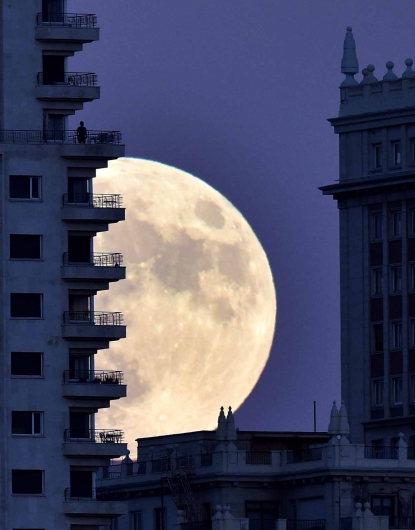 The 'supermoon' in Madrid.
(AFP / Gerard Julien)
The 'supermoon' in Madrid.
(AFP / Gerard Julien)By Gerard Julien
For us photographers the “supermoon” was an opportunity to be creative in capturing an image while scores of others are doing the same. Plus it provided a great break from the daily routine.
Having read up on the phenomenon and having checked on the times that it was due to rise over Madrid, I decided to shoot on both Sunday the 13th and on Monday the 14th, as there was a 45-minute difference in the time the moon would rise on those two days. Forty-five minutes changes everything when it comes to light in Madrid.
Armed with an 800 mm lens, I chose to shoot at the Casa de Campo park east of the city, as it offered a wide panorama of the capital along with the impressive apartment towers. And that’s how I was able to capture the huge moon between the two high rises, with a man staring on a balcony in the magic light that comes at dusk.
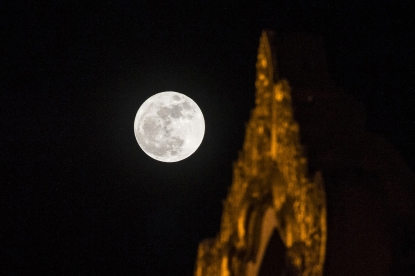 The "supermoon" rises over the Swe Taw Myat Pagoda in Yangon.
(AFP / Romeo Gacad)
The "supermoon" rises over the Swe Taw Myat Pagoda in Yangon.
(AFP / Romeo Gacad)



